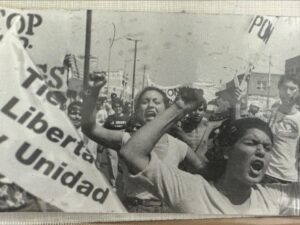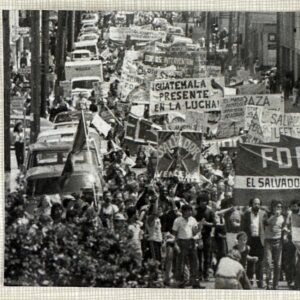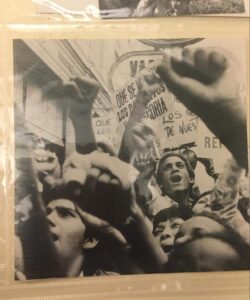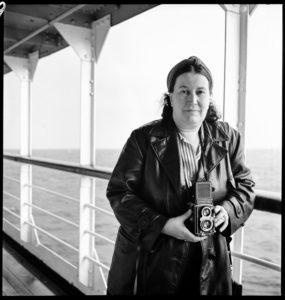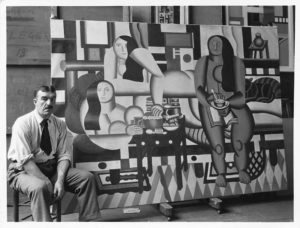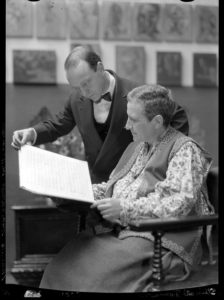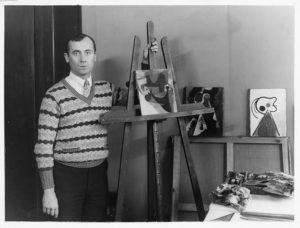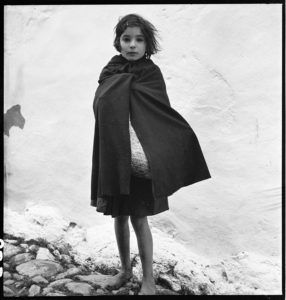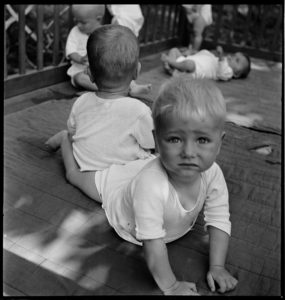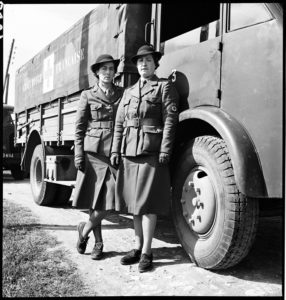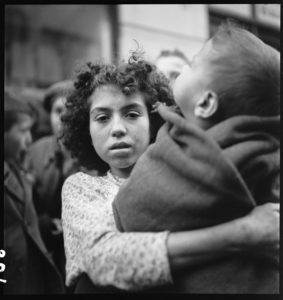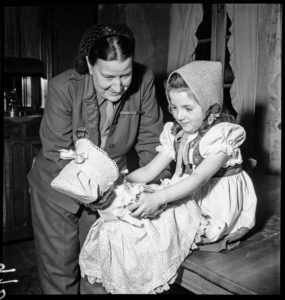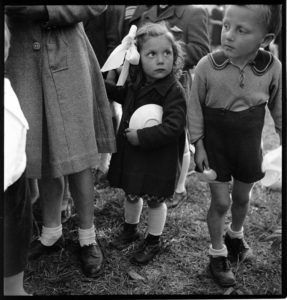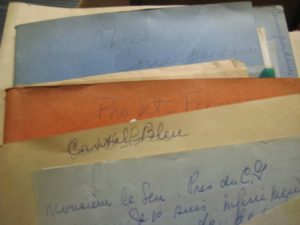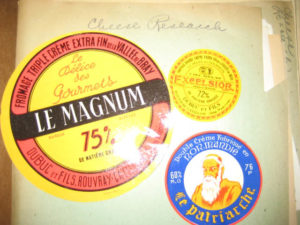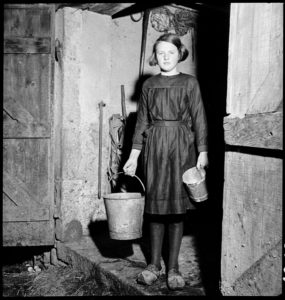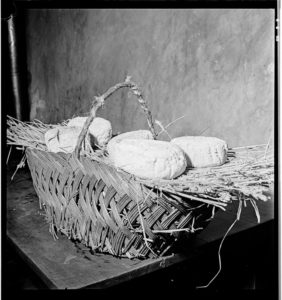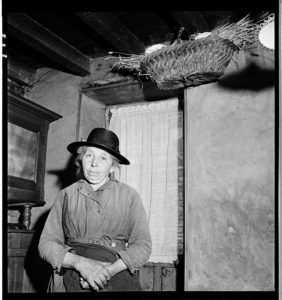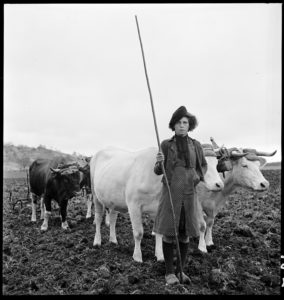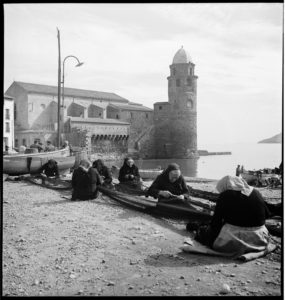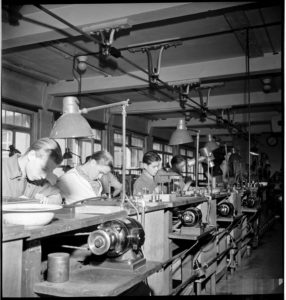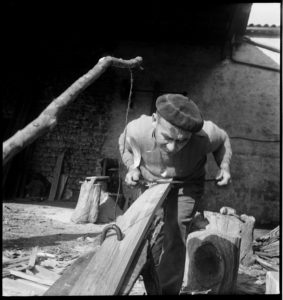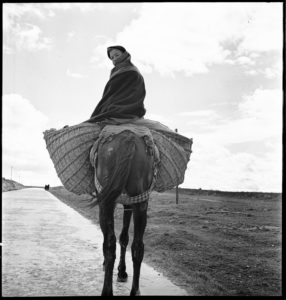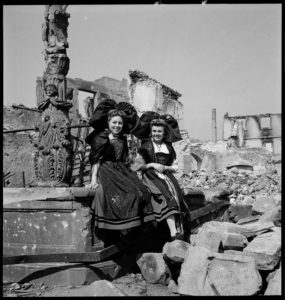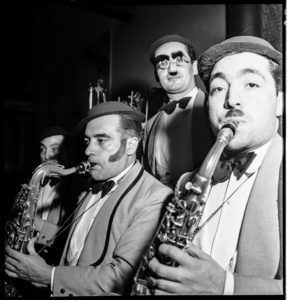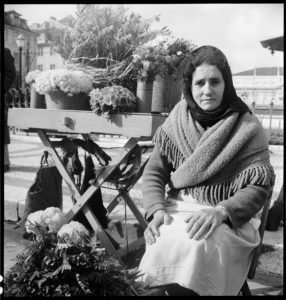Tag: archival processing
50 Years in San Francisco’s Mission District: The Archives of Acción Latina
Photographic prints and posters from the archives of Acción Latina and El Tecolote newspaper are now available for research at Bancroft Library, with an online finding aid newly published at the Online Archive of California. This is the result of the dedicated work of Isabel Breskin, an intern in Library and Information Science at the University of Washington. Below we have Isabel’s reflections on the collection, along with snapshots of a few photographs encountered while she arranged and described the files. Organizational records and other materials from Acción Latina will be made available in the coming months. -JAE
A Guest Posting by Isabel Breskin
Acción Latina is a community organization based in San Francisco’s Mission District. The roots of the organization’s work go back to 1970, when San Francisco State University journalism professor Juan Gonzalez launched a newspaper with his students. That newspaper, El Tecolote, is still published bimonthly and is now the longest-running bilingual newspaper in the country. In 1982, volunteers from El Tecolote and New College of California staged the first Encuentro del Canto Popular, a festival celebrating Latin American music. The festival became an annual event; the 41st Encuentro was held in December 2022.
The Acción Latina and El Tecolote Pictorial Archive contains thousands of photographs, hundreds of posters and artists’ prints, as well as negatives, slides, cartoons and other drawings, and digital images. The photographic print collection and the poster and artists’ print collection are now available to researchers.
The photographs capture all aspects of life in the Mission beginning around 1970 and continuing into the first decade of the 21st century, as people took to the streets to protest and celebrate, as they went to work and school, played music and danced, painted murals and listened to poetry. I found the photographs of protests particularly compelling — and I think researchers will, too. They are both rich in information about the issues and causes of the times, and moving evidence of the passion and belief that stirred people to action.
Here are just a few snapshots I took as I worked to arrange and rehouse the photographs.
As I’ve been working on the collection I’ve been thinking about all the people involved: the many people who have been part of Acción Latina over the decades, who have lived and worked in the Mission District and have contributed to the vibrancy of its community, the photographers and artists who created these materials, and the people who will now turn to the images and learn from them.
We recently had our first researcher come to use the newly available collection. He was interested in Bay Area events related to the politics and culture of Chile. Among the relevant images in the collection is this photograph.
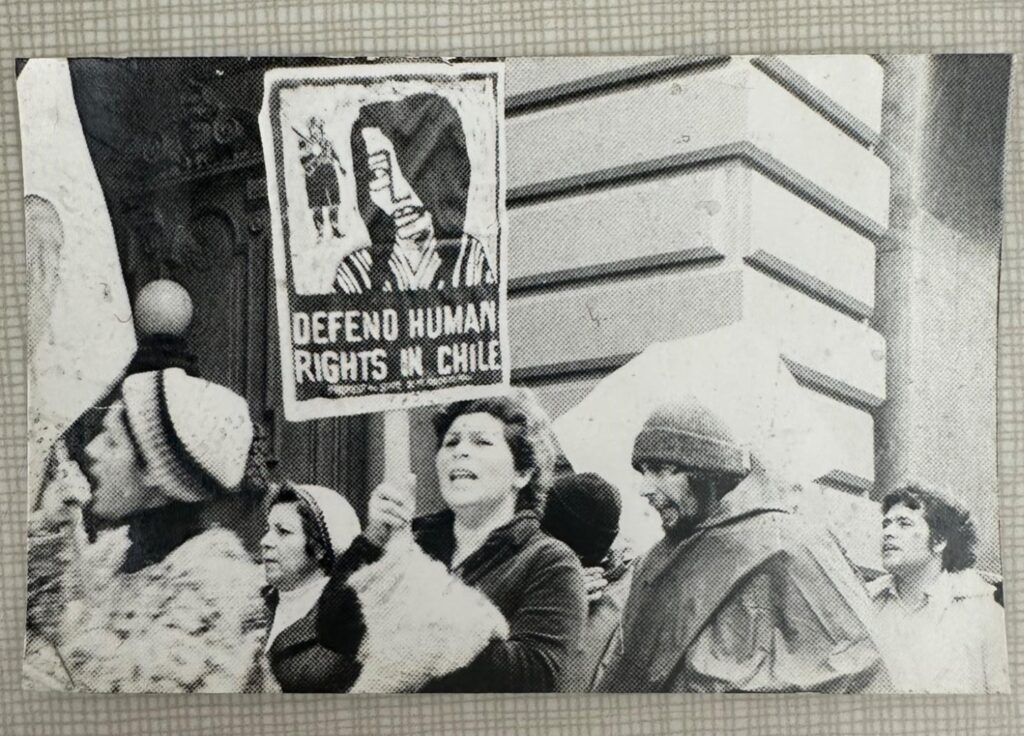
I am struck by the look on this unknown woman’s face – she looks both tragic and absolutely determined. It is meaningful to me that her decision to go out and protest that day is being preserved in the collection, and is being recognized and honored in the work of scholars.
Thérèse Bonney: Art Collector, Photojournalist, Francophile, Cheese Lover
Thérèse Bonney aboard the S.S. Siboney, en route to Portugal, 1941. BANC PIC 1982.111 series 3, NNEG box 49, item 19
Pioneering war correspondent and Cal grad Mabel Thérèse Bonney (1894-1978) was decorated with the Croix de Guerre and the Legion d’Honneur by the French government, and the Order of the White Rose of Finland for her work during World War II. Her photographs were exhibited at the Museum of Modern Art, the Library of Congress, and Carnegie Hall during her lifetime. Her work on children displaced by war spurred the United Nations to create their international children’s emergency fund, UNICEF, in 1946, and inspired the Academy Award-winning film The Search in 1948. Yet in the canon of female war photographers that includes contemporaries such as Lee Miller, Margaret Bourke-White, and Toni Frissell, Bonney rarely receives mention. Bonney was a renaissance woman whose life deserves further study, and her collections at the Bancroft Library are ripe for discovery. Manuscript Archivist Marjorie Bryer has processed The Thérèse Bonney papers, and Pictorial Archivist Sara Ferguson has digitized over 2,500 previously inaccessible nitrate negatives from the Thérèse Bonney Photograph Collection.
ART CONNOISSEUR
While living in Paris in the 1920s and 1930s, Bonney modeled for fashion designers like Sonia Delaunay and Madeleine Vionnet, and became friends with many of the most famous artists and writers of her day, including Raoul Dufy, Gertrude Stein, and George Bernard Shaw. In 1924 Bonney founded an international photo service that licensed images acquired in France for publication in the U.S. She was often dissatisfied with the images she distributed, and this inspired her to take up photography herself. Bonney wrote about, and took photographs of, many of the artists and writers in her life throughout the twenties, thirties, and forties.
PHOTOJOURNALISM AND WAR RELIEF EFFORTS
Bonney photographed throughout Europe during World War II, focusing on the effects of war on the civilian population. Her photographs of children were particularly moving and resulted in her most famous work, the exhibit and book, Europe’s Children. Bonney was actively involved with relief efforts after the war, particularly in the Alsace region of France. She also founded a number of organizations dedicated to promoting friendship between citizens of France and the United States, and improving Franco-American political relations. One effort, the Chain d’Amite, encouraged French families to open their homes to American G.I.s; another, Project Patriotism, inspired airmen who were shot down in France to help the families that had rescued them. Project Patriotism eventually spread to other European countries, including the Netherlands. Marjorie’s father-in-law, Peter, was a teenager when Germany invaded the Netherlands during the war. He was sent to live with relatives in the Dutch countryside so he wouldn’t be conscripted. One of Peter’s most moving stories was about the American pilot his family hid when his plane crashed on the family farm. Bonney’s papers include many poignant letters from U.S. soldiers and, while processing the collection, Marjorie wondered what this airman from Brooklyn might have written about his experiences with his Dutch “family.”
LOVER OF CHEESE
Bonney’s many interests included food and cooking. She and her sister, Louise, wrote a guide to Paris restaurants and a cookbook, French cooking for American kitchens. Her papers include her research on cheese, which she referred to as “Project Fromage.” Series 7 of Bonney’s papers include meticulous notes on various cheeses from France and the Netherlands, “technical” correspondence about cheese, and materials related to tyrosemiophilia — the hobby of collecting cheese labels.
EVERYDAY PEOPLE AND LIFE DURING WARTIME
Bonney documented daily life during wartime across Europe. She recorded entire communities — their families, customs, and industries, their artists and politicians, their schools, and their churches. Her papers and photographs show not only the horrors of war but the hope and perseverance of those who lived through it.
NOW AVAILABLE AT THE BANCROFT LIBRARY!
Newly digitized portions of the pictorial collection include Series 6: France, Germany 1944-1946. This series includes photographs of concentration camps Vaihingen, Buchenwald, and Dachau; Displaced Person camps; Neuschwanstein Castle; and Hermann Göring’s Collection of art looted by the Nazi’s. It also includes many images of the heavily bombarded town of Ammerschwihr in Alsace, France and war relief efforts there. Future digitization efforts will focus on Series 3, Carnegie Corporation Trip: Portugal, Spain, France 1941-1942. This series consists of images taken while on a grant from the Carnegie Corporation of New York to document the effects of war on civilian populations. It includes images of military personnel, civilian industries, and Red Cross operations. Famous personalities pictured in this series include Pierre Bonnard, Henri Matisse, Georges Roualt, Gertrude Stein, Philippe Petain, Raoul Dufy, and Aristide Maillol.
Bonney’s papers help contextualize her photographs. They include correspondence; personal materials; her writings (autobiographical and articles about others); and her files on World War II, Franco-American relations, art, fashion, photography, and cheese.
Both collections are open for research:
Finding Aid to the Thérèse Bonney Photograph Collection, circa 1850-circa 1955 (bulk 1930-1945)
Finding Aid to the Thérèse Bonney Papers
— Marjorie Bryer and Sara Ferguson
1915 Panama-Pacific International Exposition: Stories through Photographs
A guest posting by Seamus Howard, Student Archival Processing Assistant in the Pictorial Unit, Bancroft Library
What makes a photograph good?
As a student working in the Bancroft Pictorial Unit, I’ve been going through hundreds and hundreds of photographs daily. I’ve seen my share of good and bad photos.
One might stand out as “good” due to the lighting, crisp focus, correct staging, and exposure — good cropping perhaps, or just clarity of subject. Ultimately, the answer is a combination of factors, and can be completely subjective.
For me, the most important factor is moment.
The 1915 Panama Pacific International Exposition was full of special moments captured in photographs which continue to shed light on the character and tone of the United States during the early 20th century.
One special moment was former President William Howard Taft visiting the P.P.I.E.
Working to re-house and inventory about 6,700 photographic prints in large, brittle ledger books, I’ve encountered numerous shots of this visit, thoroughly recorded by the Cardinell-Vincent Company, the exposition’s official photographers.
President Taft was an early supporter of the exposition, declaring in early 1911 that San Francisco would be the official home of the fair. He attended the groundbreaking eight months later and returned to San Francisco in 1915 to see the fair in all its glory.
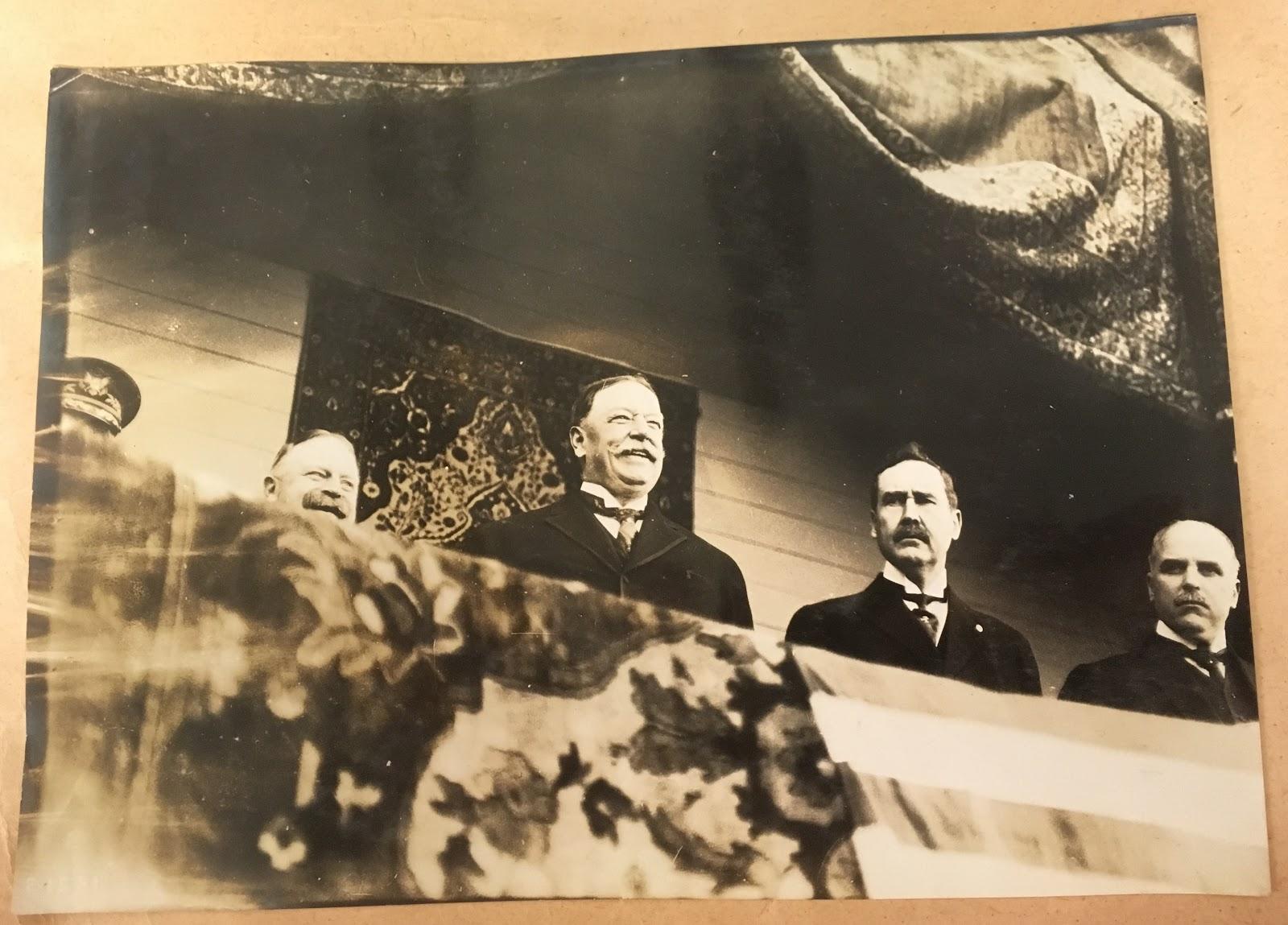
Taft’s visit to the fair was seemingly a large event. He was accompanied wherever he went, soldiers or guards escorting him from building to building. Taft continued to be a very important person at this time. He had lost his reelection to Wilson in 1912, and returned to Yale as a professor of law and government.
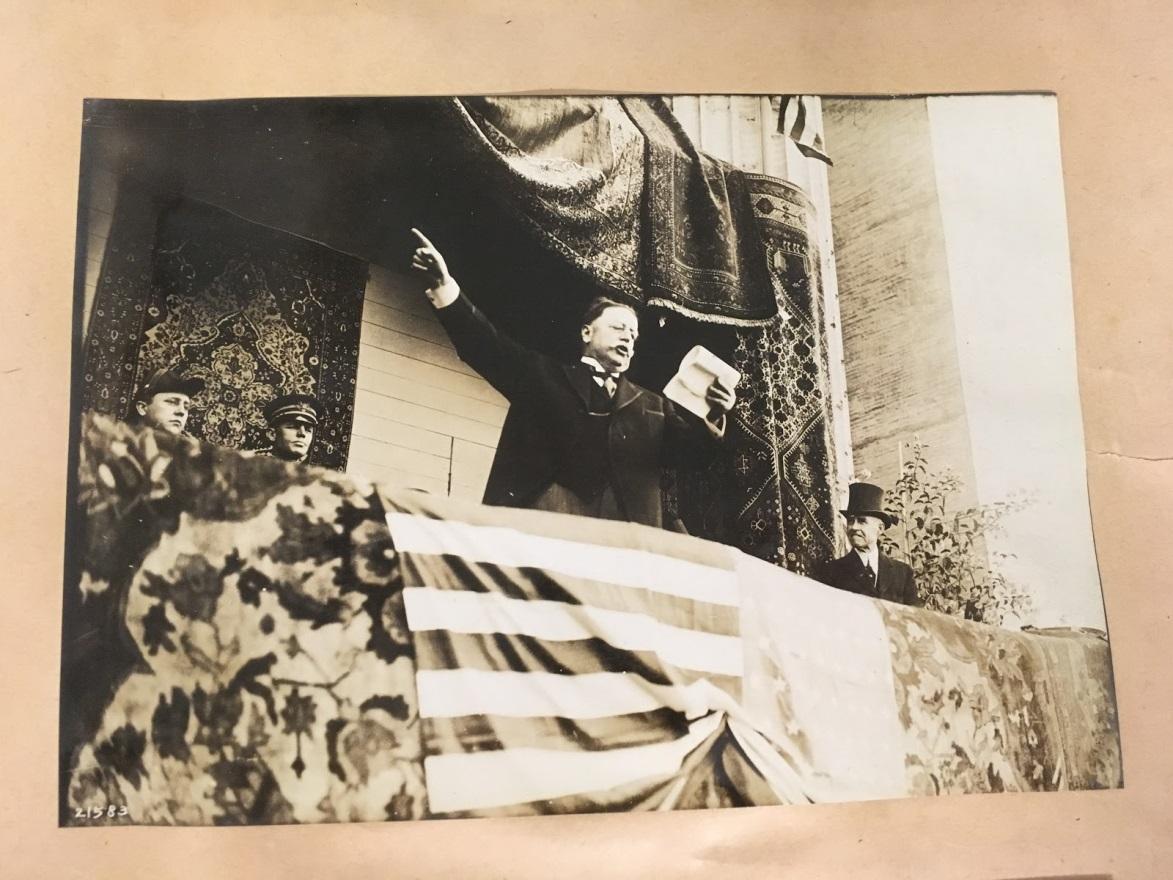
Taft visited many of the fair’s popular buildings and exhibits, including the Japanese Pavilion, Swedish Building, Norway Building, and the art gallery and courtyard of the French Pavilion. He met foreign representatives, fair officials, and experienced much of what the fair had to offer.


And President Taft experienced the unique blend of cultures and stories the fair provided. Here, in my favorite photograph of Taft’s time at the fair, he walks through a hall lined with busts in the Swedish building, flanked by guards. Taft seems enveloped by the art and is perfectly framed between his escorts and the lines of busts, drawing your eye towards Taft at the center. This moment makes a great photograph.
The Bancroft Pictorial team continues to house and describe the collection, and will update this blog with more photographs and details as we progress. Stay tuned!
BANCROFT SUMMER ARCHIVAL INTERNSHIP 2015
The Bancroft Library University of California Berkeley
SUMMER ARCHIVAL INTERNSHIP 2015
Who is Eligible to Apply
Graduate students currently attending an ALA accredited library and information science program who have taken coursework in archival administration and/or digital libraries.
Born-Digital Processing Internship Duties
The Born-Digital Processing Intern will be involved with all aspects of digital collections work, including inventory control of digital accessions, collection appraisal, processing, description, preservation, and provisioning for access. Under the supervision of the Digital Archivist, the intern will analyze the status of a born-digital manuscript or photograph collection and propose and carry out a processing plan to arrange and provide access to the collection. The intern will gain experience in appraisal, arrangement, and description of born-digital materials. She/he will use digital forensics software and hardware to work with disk images and execute processes to identify duplicate files and sensitive/confidential material. The intern will create an access copy of the collection and, if necessary, normalize access files to a standard format. The intern will generate an EAD-encoded finding aid in The Bancroft Library’s instance of ArchivesSpace for presentation on the Online Archive of California (OAC). Lastly, the intern will complete a full collection-level MARC catalog record for the collection using the University Library’s Millennium cataloging system. All work will occur in the Bancroft Technical Services Department, and interns will attend relevant staff meetings.
Duration:
6 weeks (minimum 120 hours), June 29 – August 7, 2015 (dates are somewhat flexible)
NOTE: The internship is not funded, however, it may be possible to arrange for course credit for the internship. Interns will be responsible for living expenses related to the internship (housing, transportation, food, etc.).
Application Procedure:
The competitive selection process is based on an evaluation of the following application materials:
Cover letter & Resume
Current graduate school transcript (unofficial)
Photocopy of driver’s license (proof of residency if out-of-state school)
Letter of recommendation from a graduate school faculty member
Sample of the applicant’s academic writing or a completed finding aid
All application materials must be postmarked on or before Friday, April 17, 2015 and either mailed to:
Mary Elings
Head of Digital Collections
The Bancroft Library
University of California Berkeley
Berkeley, CA 94720.
or emailed to melings [at] library.berkeley.edu, with “Born Digital Processing Internship” in the subject line.
Selected candidates will be notified of decisions by May 1, 2015.
Bancroft Library Processes First Born-Digital Collection
The Bancroft Library’s Digital Collections Unit recently finished a pilot project to process its first born-digital archival collection: the Ladies’ Relief Society records, 1999-2004. Based on earlier work and recommendations by the Bancroft Digital Curation Committee (Mary Elings, Amy Croft, Margo Padilla, Josh Schneider, and David Uhlich) we’re implementing best-practice procedures for acquiring, preserving, surveying, and describing born-digital files for discovery and use.
Read more about our efforts below, and check back soon for further updates on born-digital collections.
State of the Digital Archives: Processing Born-Digital Collections at the Bancroft Library (PDF)
Abstract:
This paper provides an overview of work currently being done in the Bancroft’s Digital Collections Unit to preserve, process, and provide access to born-digital collections. It includes background information about the Bancroft’s Born Digital Curation Program and discusses the development of workflows and strategies for processing born-digital content, including disk imaging, media inventories, hardware and software needs and support, arrangement, screening for sensitive content, and description. The paper also describes DCU’s pilot processing project of the born-digital files from the Ladies’ Relief Society records.
Bancroft to Explore Text Analysis as Aid in Analyzing, Processing, and Providing Access to Text-based Archival Collections
Mary W. Elings, Head of Digital Collections, The Bancroft Library
The Bancroft Library recently began testing a theory discussed at the Radcliffe Workshop on Technology & Archival Processing held at Harvard’s Radcliffe College in early April 2014. The theory suggested that archives can use text analysis tools and topic modelling — a type of statistical model for discovering the abstract “topics” that occur in a collection of documents — to analyze text-based archival collections in order to aid in analyzing, processing and describing collections, as well as improving access.
Helping us to test this theory, the Bancroft welcomed summer intern Janine Heiser from the UC Berkeley School of Information. Over the summer, supported by an ISchool Summer Non-profit Internship Grant, Ms. Heiser worked with digitized analog archival materials to test this theory, answer specific research questions, and define use cases that will help us determine if text analysis and topic modelling are viable technologies to aid us in our archival work. Based on her work over the summer, the Bancroft has recently awarded Ms. Heiser an Archival Technologies Fellowship for 2015 so that she can continue the work she began in the summer and further develop and test her work.
During her summer internship, Ms. Heiser created a web-based application, called “ArchExtract” that extracts topics and named entities (people, places, subjects, dates, etc.) from a given collection. This application implements and extends various natural language processing software tools such as MALLET and the Stanford Core NLP toolkit. To test and refine this web application, Ms. Heiser used collections with an existing catalog record and/or finding aid, namely the John Muir Correspondence collection, which was digitized in 2009.
For a given collection, an archivist can compare the topics and named entities that ArchExtract outputs to the topics found in the extant descriptive information, looking at the similarities and differences between the two in order to verify ArchExtract’s accuracy. After evaluating the accuracy, the ArchExtract application can be improved and/or refined.
Ms. Heiser also worked with collections that either have minimal description or no extant description in order to further explore this theory as we test the tool further. Working with Bancroft archivists, Ms. Heiser will determine if the web application is successful, where it falls short, and what the next steps might be in exploring this and other text analysis tools to aid in processing collections.
The hope is that automated text analysis will be a way for libraries and archives to use this technology to readily identify the major topics found in a collection, and potentially identify named entities found in the text, and their frequency, thus giving archivists a good understanding of the scope and content of a collection before it is processed. This could help in identifying processing priorities, funding opportunities, and ultimately helping users identify what is found in the collection.
Ms. Heiser is a second year masters’ student at the UC Berkeley School of Information where she is learning the theory and practice of storing, retrieving and analyzing digital information in a variety of contexts and is currently taking coursework in natural language processing with Marti Hearst. Prior to the ISchool, Ms. Heiser worked at several companies where she helped develop database systems and software for political parties, non-profits organizations, and an online music distributor. In her free time, she likes to go running and hiking around the bay area. Ms. Heiser was also one of our participants in the #HackFSM hackathon! She was awarded an ISchool Summer Non-profit Internship Grant to support her work at Bancroft this summer and has been awarded an Archival Technologies Fellowship at Bancroft for 2015.
